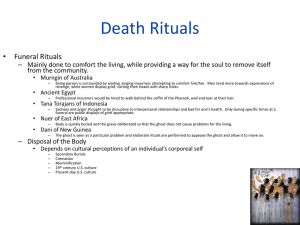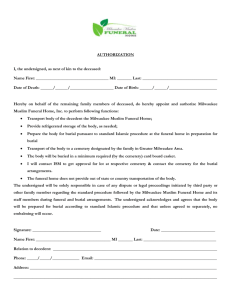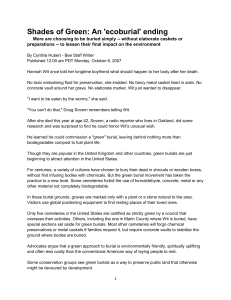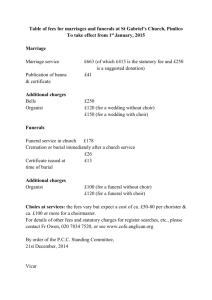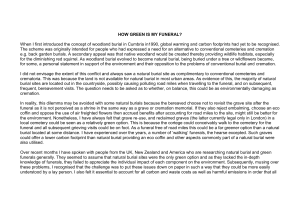http://www
advertisement
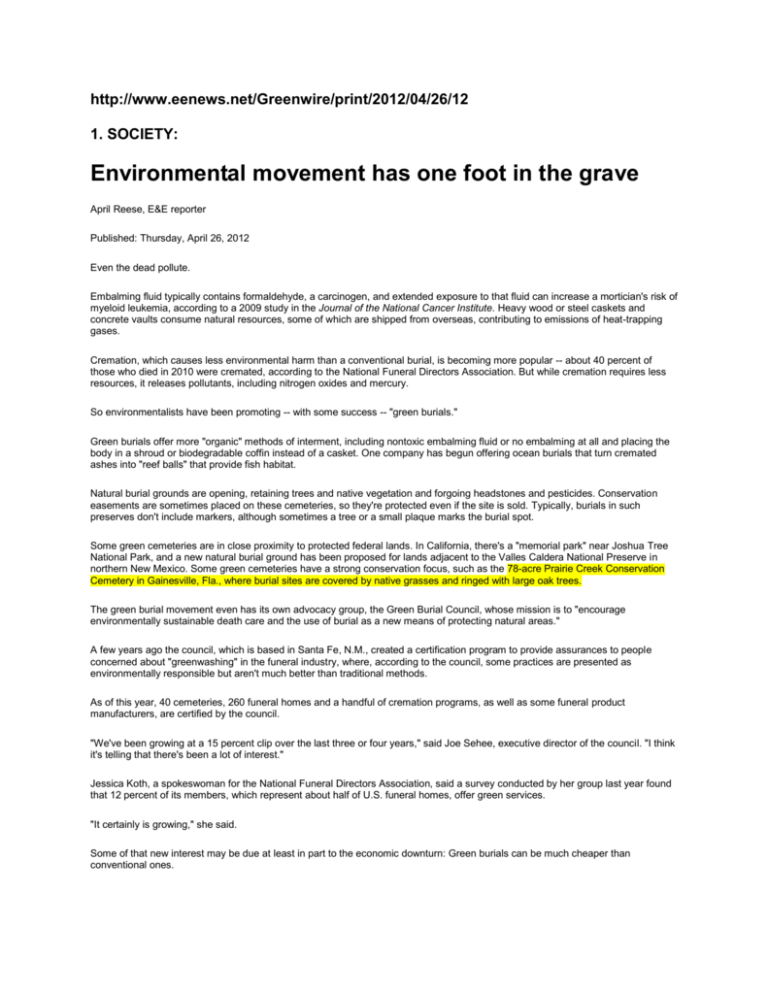
http://www.eenews.net/Greenwire/print/2012/04/26/12 1. SOCIETY: Environmental movement has one foot in the grave April Reese, E&E reporter Published: Thursday, April 26, 2012 Even the dead pollute. Embalming fluid typically contains formaldehyde, a carcinogen, and extended exposure to that fluid can increase a mortician's risk of myeloid leukemia, according to a 2009 study in the Journal of the National Cancer Institute. Heavy wood or steel caskets and concrete vaults consume natural resources, some of which are shipped from overseas, contributing to emissions of heat-trapping gases. Cremation, which causes less environmental harm than a conventional burial, is becoming more popular -- about 40 percent of those who died in 2010 were cremated, according to the National Funeral Directors Association. But while cremation requires less resources, it releases pollutants, including nitrogen oxides and mercury. So environmentalists have been promoting -- with some success -- "green burials." Green burials offer more "organic" methods of interment, including nontoxic embalming fluid or no embalming at all and placing the body in a shroud or biodegradable coffin instead of a casket. One company has begun offering ocean burials that turn cremated ashes into "reef balls" that provide fish habitat. Natural burial grounds are opening, retaining trees and native vegetation and forgoing headstones and pesticides. Conservation easements are sometimes placed on these cemeteries, so they're protected even if the site is sold. Typically, burials in such preserves don't include markers, although sometimes a tree or a small plaque marks the burial spot. Some green cemeteries are in close proximity to protected federal lands. In California, there's a "memorial park" near Joshua Tree National Park, and a new natural burial ground has been proposed for lands adjacent to the Valles Caldera National Preserve in northern New Mexico. Some green cemeteries have a strong conservation focus, such as the 78-acre Prairie Creek Conservation Cemetery in Gainesville, Fla., where burial sites are covered by native grasses and ringed with large oak trees. The green burial movement even has its own advocacy group, the Green Burial Council, whose mission is to "encourage environmentally sustainable death care and the use of burial as a new means of protecting natural areas." A few years ago the council, which is based in Santa Fe, N.M., created a certification program to provide assurances to people concerned about "greenwashing" in the funeral industry, where, according to the council, some practices are presented as environmentally responsible but aren't much better than traditional methods. As of this year, 40 cemeteries, 260 funeral homes and a handful of cremation programs, as well as some funeral product manufacturers, are certified by the council. "We've been growing at a 15 percent clip over the last three or four years," said Joe Sehee, executive director of the council. "I think it's telling that there's been a lot of interest." Jessica Koth, a spokeswoman for the National Funeral Directors Association, said a survey conducted by her group last year found that 12 percent of its members, which represent about half of U.S. funeral homes, offer green services. "It certainly is growing," she said. Some of that new interest may be due at least in part to the economic downturn: Green burials can be much cheaper than conventional ones. According to the funeral directors' group, the average burial in the United States cost about $6,560 in 2009. But the price for a green burial often runs about half that, primarily because of the money saved on caskets, embalming and body preparation, and headstones. Simplifying the burial process to decrease a person's posthumous ecological footprint essentially returns funeral practices to the preCivil War way of handling burials. During the war, embalming was used to preserve bodies of soldiers so they could be returned home for burial. "One hundred years ago, using the chemicals of tomorrow today seemed like a cool idea because we were concerned about cholera and other diseases," Sehee said. "Today it seems like it's a horrible use of precious resources." Bringing an environmental ethic to the funeral industry has its challenges, though, Sehee added. "At first glance it seems so easy, but there are so many dots that have to be connected," Sehee said, "because you're talking about a $20 million industry and the conservation industry that has to be involved, I think. How do you build a bridge between those two folks? But I'm proud of the progress we've made." In a 2010 public survey by the Funeral and Memorialization Information Council -- its first to include survey questions about green funeral services -- 66 percent of respondents were not aware that such options are available. But when asked if they'd be interested in those services, 47 percent said they would. That number seems likely to grow as more funeral directors recognize the potential of green burials to set them apart from the competition. "I think there are many funeral directors who are actively marketing the fact that they offer green funerals, and are getting families to understand all of the options available to them," Koth said. Reese writes from Santa Fe, N.M.

